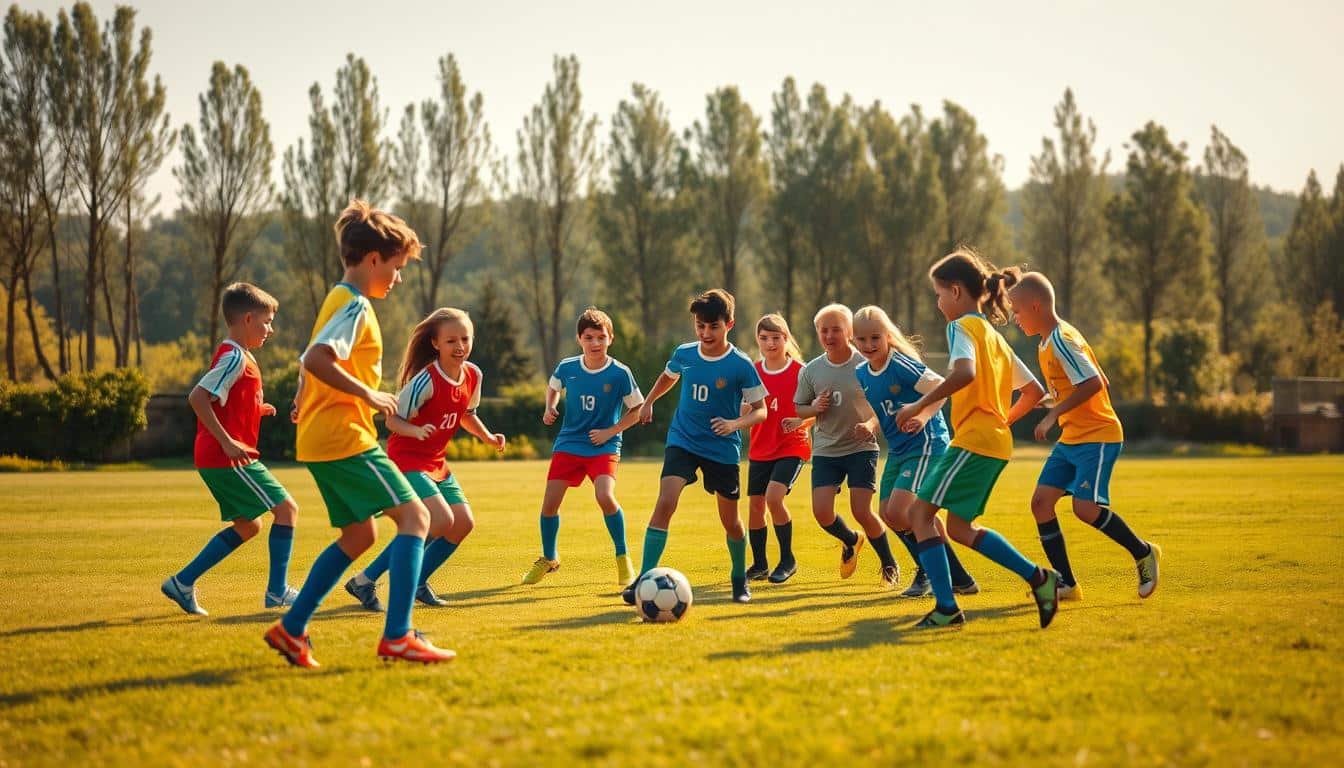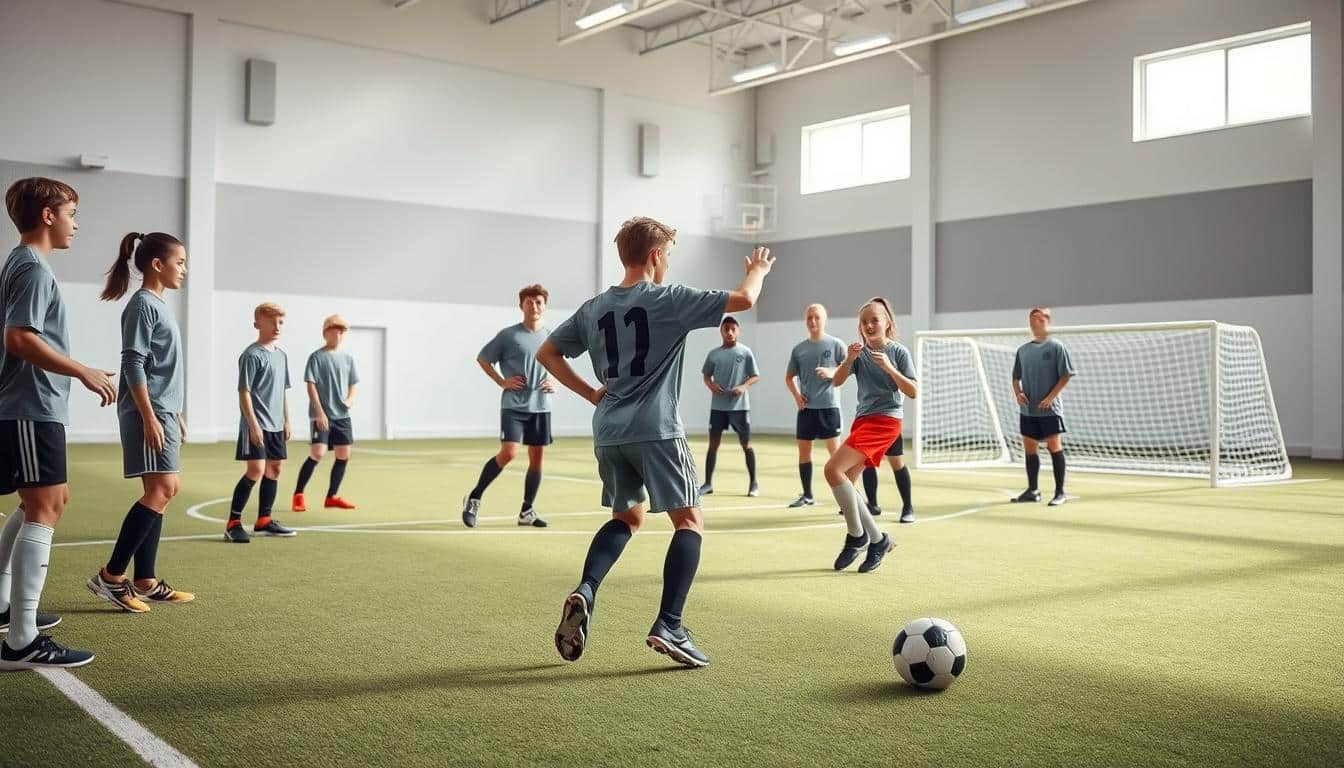Team Spirit Activities for Soccer Kids

Does your group struggle with communication during matches? Building trust among young athletes is the foundation of winning strategies. Simple, fun exercises can transform how players work together – both on and off the field.
Great squads don’t just happen. They’re built through shared challenges that teach cooperation. When kids learn to rely on each other in practice drills, those skills shine during intense moments in games.
You’ll notice improvements quickly. Better passing decisions. Smoother defensive rotations. Even quieter athletes start speaking up. These aren’t just playtime games – they’re confidence builders that create lasting bonds.
Key Takeaways
- Group challenges boost communication during matches
- Trust-building drills improve on-field coordination
- Fun exercises help shy participants engage more
- Shared experiences strengthen long-term relationships
- Simple games teach quick decision-making under pressure
Why Team Building Matters for Young Soccer Players
Young athletes thrive when they feel connected to their peers. Team building activities create bonds that transform how groups perform under pressure. These exercises aren’t just fun – they’re practice for real-game situations where split-second decisions matter.
| Skill Developed | With Team Building | Without Team Building |
|---|---|---|
| Communication | Crisp passing calls | Missed opportunities |
| Trust | Automatic coverage | Defensive gaps |
| Leadership | Multiple vocal guides | Silent confusion |
Shared challenges during practice help athletes understand each other’s strengths. When players know who tracks back fastest or delivers pinpoint crosses, they coordinate plays instinctively. This awareness turns individual talent into group success.
Regular group exercises also build resilience. Players learn to reset after mistakes rather than blame teammates. That positive mindset becomes your secret weapon during tied games or tournament finals.
Soccer team spirit activities
Ever notice how some squads move like a single unit on the field? The right exercises turn individual effort into synchronized success. Mix up your practice plans with these engaging methods that strengthen bonds and sharpen group instincts.
Communication boosters like blindfolded drills push athletes to articulate strategies clearly. Players learn to listen actively and give precise directions – skills that translate directly to match situations.
Creative collaborations work wonders. Have your group design obstacle courses together or invent new warm-up routines. These tasks encourage self-expression while aligning everyone toward common goals.
Physical coordination challenges build mutual reliance. Try partner passing sequences where pairs must mirror each other’s movements. When one struggles, teammates naturally step in to assist.
- Timed puzzle-solving huddles develop quick thinking
- Rhythm-based movement games break down social barriers
- Trust falls adapted for field scenarios build dependency
Adjust difficulty levels based on age and skill. Younger groups might focus on high-energy icebreakers, while advanced players tackle complex tactical simulations. The best part? These methods feel like play while forging unbreakable connections.
Blind Drawing: A Creative Communication Challenge
Clear instructions win matches – but how do you teach that skill? This simple group game reveals why precise language matters in high-pressure moments. Players discover firsthand how assumptions derail teamwork and how details make all the difference.
How the Game Works
Split participants into groups of 4-6. Each picks an object like a key or coin. One person draws it while facing away, relying only on teammates’ descriptions. No questions allowed – just 3 minutes of creative guidance.
| Component | Details |
|---|---|
| Time Needed | 25 minutes |
| Group Size | 4-30 players |
| Materials | Paper, pens, household items |
| Success Rate | 72% accuracy with practice |
Tips for Clear Descriptions
Start with basic shapes: “Draw a circle the size of a quarter.” Add details gradually: “Put three lines crossing the center.” Avoid naming the object – focus on its parts.
Switch to sports gear for advanced rounds. Describe shin guards as “rectangles with rounded edges” or cleats as “ovals with dotted patterns.” Laughter over mismatched drawings breaks tension while reinforcing the need for accuracy.
After three rounds, groups naturally develop shorthand terms. These shared references become their secret weapon during time-sensitive plays. You’ll see better-organized passes and smarter defensive calls in the next match.
Reverse Charades: Acting Out the Playbook
What if your squad could practice strategy without a ball? This high-energy twist on classic charades flips the script – everyone acts while one person guesses. It’s perfect for groups where some athletes hesitate to take center stage alone.

Setting Up the Challenge
Grab a smartphone with a reverse charades app or prepare printed cards. Split into groups of 5-7 players. Each round lasts 60 seconds – teams must act out soccer terms like “corner kick” or “offside trap” silently. The guesser wins points for every correct answer.
| Element | Details | Purpose |
|---|---|---|
| Time Limit | 60 seconds/round | Mimics game pressure |
| Group Size | 4-20 players | Ensures full involvement |
| Custom Words | Formations, gear, plays | Builds sport-specific IQ |
Encouraging Team Participation
Shy team members thrive here – they contribute gestures without solo pressure. Watch quiet players become animated when signaling “penalty shot” through group movements. You’ll see natural leaders emerge as they organize silent choreography.
Create word lists matching your playbook for deeper learning. Include terms like “4-4-2 formation” or “through ball”. The game becomes a stealth training tool where teamwork shapes clearer non-verbal communication.
Rotate guessers each round to build versatile skills. This approach keeps all players engaged while reinforcing that every person’s role matters – just like during matches.
Sneak a Peek: Sharpening Descriptive Skills
Can describing an object in seconds improve how players coordinate during matches? This hands-on challenge turns precise communication into an engaging race against the clock. Groups learn to translate visual details into clear instructions – a skill that directly impacts on-field decision-making.
Essential Components
| Element | Details |
|---|---|
| Time Limit | 20 minutes total |
| Participants | 2-20 players |
| Materials | Clay, Legos, toothpicks |
| Goal | Replicate hidden objects |
Divide your group into pairs or small teams. One person from each unit studies a concealed sculpture for 10 seconds – maybe a mini trophy or formation model. They return to describe it while others build using only verbal cues.
Watch leaders emerge as describers learn to break down complex shapes. Phrases like “flattened cylinder with crossed sticks” replace vague terms. Builders practice asking focused questions: “Which side has the notch?”
This activity reveals how assumptions derail progress. When two teams interpret “angled base” differently, they discover the value of specific language. Use sport-themed objects to connect the exercise to real-game scenarios.
- Develops quick-thinking description skills
- Encourages active listening and clarification
- Strengthens trust in teammates’ observations
Rotate describers to give everyone leadership practice. You’ll notice improved huddle communication as players adopt precise terms learned during this creative challenge.
Conducted Story: Crafting a Team Narrative
What if storytelling could turn individual voices into a powerful chorus? This group exercise transforms random ideas into cohesive tales, teaching participants how collaboration creates magic. No props needed – just imagination and attentive ears.
Step-by-Step Story Building
Gather your group in a tight circle. Choose one person to conduct – they’ll keep the narrative flowing smoothly. Start with a soccer-themed opener like “The underdogs entered halftime trailing by three goals when…” Each player adds one sentence, building on previous contributions.
Watch quieter team members gain confidence as their ideas shape the plot. The conductor gently redirects if the story veers off course, ensuring everyone stays engaged. After three rounds, groups naturally develop inside jokes and shared references.
Follow-Up Prompts for Better Unity
Challenge your circle with twists: “Now tell the story backward” or “Add a magical element.” These variations push players to adapt quickly – just like adjusting tactics mid-game. Discuss how the exercise mirrors field communication:
- Why did certain story directions work better?
- How did the group recover from confusing plot turns?
- What made some contributions more impactful?
This activity proves teams must value every voice to succeed. Players discover unexpected connections between storytelling and gameplay – both require listening, adapting, and trusting the process. The shared narrative becomes a metaphor for their season’s journey.
Swedish Story: Transforming Words into Action
Imagine transforming random shouts into cohesive strategies. This team building activity turns chaotic ideas into collaborative triumphs. Groups create spontaneous narratives while practicing crucial skills for game-day success.
Pair up participants or form small teams of 3-4. Choose one storyteller per group – they’ll craft tales about soccer milestones. Others become word wizards, shouting unexpected terms like “pineapple” or “spaceship” that must flow naturally into the plot.
The magic happens through forced creativity. When storytellers weave “volcano” into a penalty kick scenario, they learn to adapt mid-play. Word givers discover the great way to support peers without stealing focus – just like assisting goals rather than always shooting.
- Develops split-second decision making
- Strengthens verbal improvisation skills
- Teaches supportive participation
- Builds mental flexibility for game surprises
Watch quiet people blossom as they realize their random words shape the story. Leaders emerge through graceful navigation of plot twists. Everyone practices staying calm when plans change – exactly like adjusting tactics after an opponent scores.
This activity requires zero equipment but delivers powerful results. In 15-30 minutes, groups bond through laughter while sharpening skills that translate directly to field success. The real goal? Turning individual voices into championship-caliber collaboration.
Tied Up: Overcoming Constraints Together
Working under constraints reveals true teamwork potential. This hands-on exercise uses physical bonds to teach athletes how collective effort solves problems. Groups discover creative ways to communicate when standard methods fail.
Activity Goals and Rules
| Element | Details |
|---|---|
| Time | 15-30 minutes |
| Participants | 3-15 players |
| Materials | Rope, bandanas, string |
| Primary Goal | Complete tasks with tied hands |
Connect participants’ wrists in a circle using soft ties. Present simple objectives like wrapping a gift box or building a cup tower. Teams must coordinate movements without breaking the chain.
Learning from Communication Challenges
Players quickly realize everyone contributes to success. Passing scissors becomes a group effort – one holds the tool while others position materials. Mistakes like dropped items teach patience and adaptive thinking.
This team building activity mirrors field dynamics. Just as connected players adjust their stance, athletes learn to reposition during plays instinctively. Shared struggles bond team members through laughter and creative problem-solving.
After three attempts, groups develop non-verbal signals and task分工. These skills transfer directly to game scenarios where quick adjustments decide outcomes. The real victory? Understanding limitations become opportunities when approached together.
Bounden: Partner Dance for Coordination
Ever watched dancers move in perfect sync without saying a word? This innovative building activity transforms rhythm into teamwork fuel. Partners hold opposite ends of a smartphone while following on-screen dance cues – a modern twist on classic coordination drills.
The magic happens through shared focus. Moves require mirroring steps and adjusting speed together. At first, giggles erupt as knees bump. But within minutes, pairs develop fluid motions that resemble seasoned dance partners.
Why does this work? It forces athletes to anticipate rather than react. Just like reading a play before it unfolds, participants learn to sense shifts in momentum. These skills translate directly to dynamic game situations where split-second alignment decides outcomes.
No dance experience needed. The app’s playful design keeps things light while teaching serious lessons. Partners discover how subtle weight shifts communicate intent – perfect for building non-verbal understanding during high-pressure moments.
Groups leave energized, having turned potential awkwardness into collective triumphs. That’s the power of movement-based building activities. They prove coordination grows when challenges feel like celebrations, not chores.
